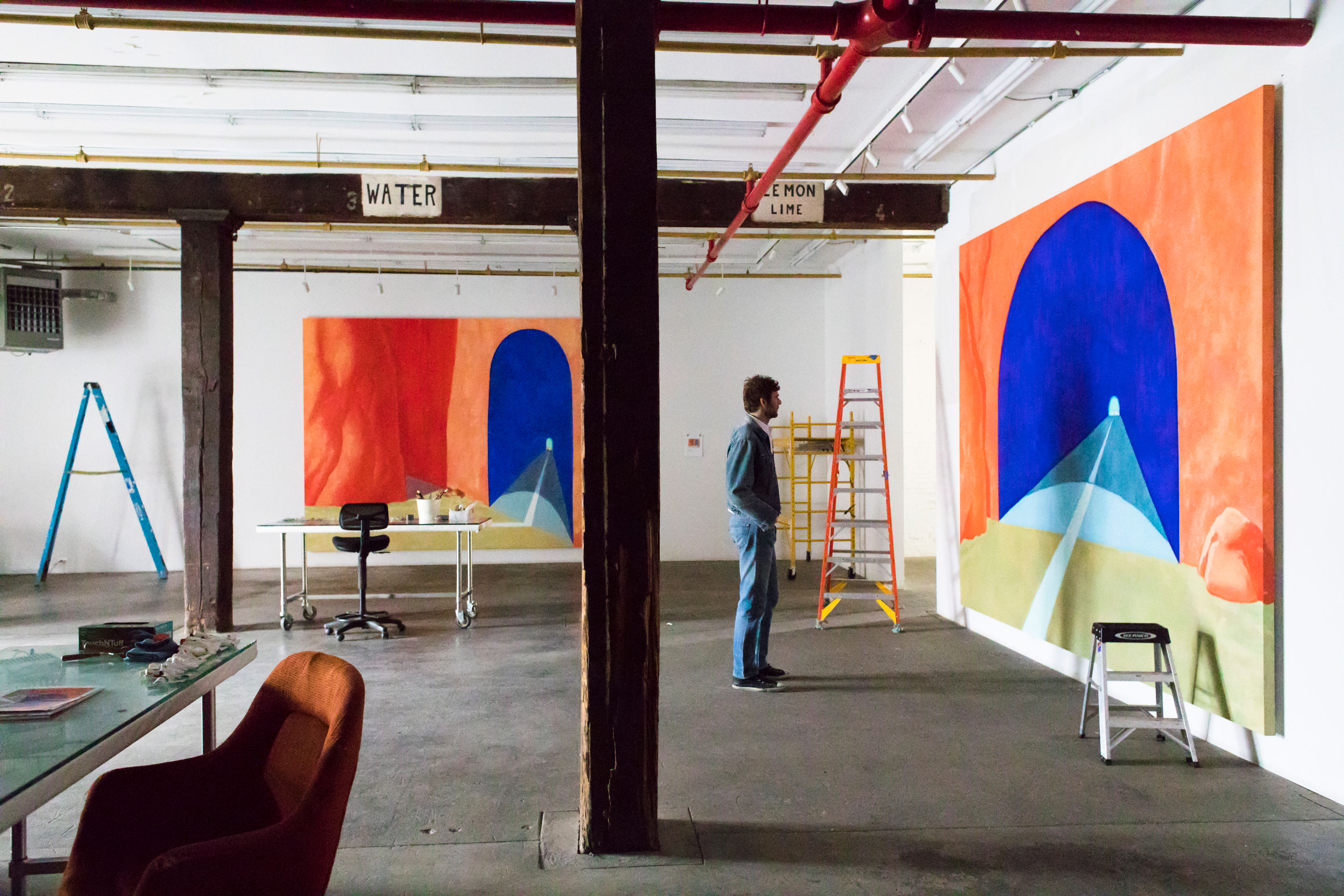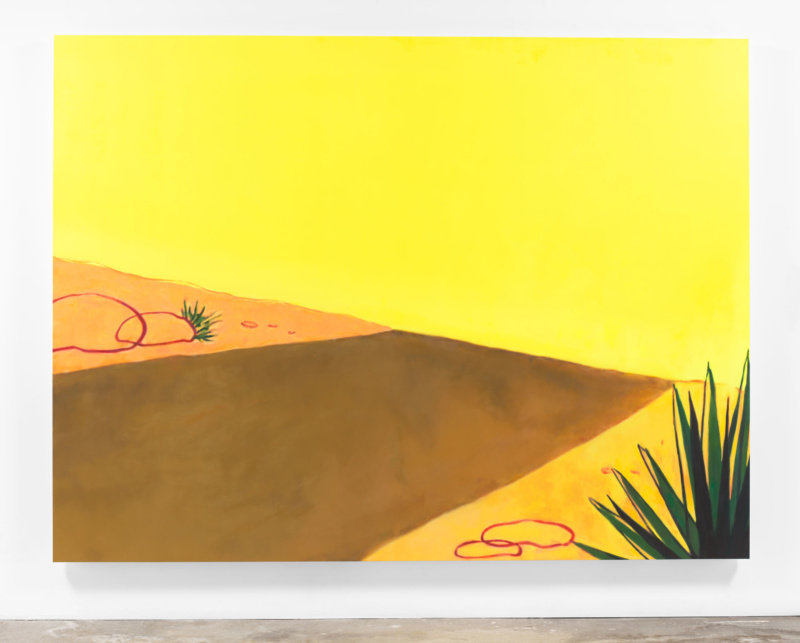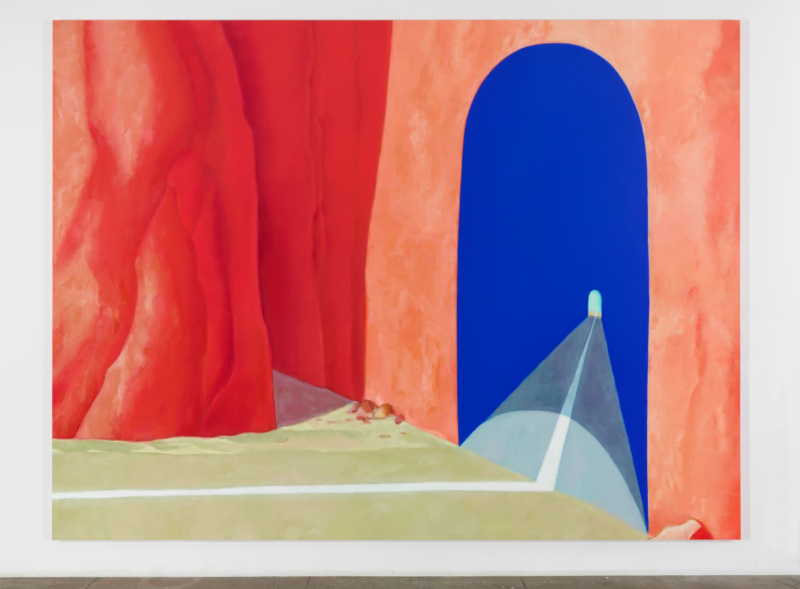
Dan Colen has spent the past few years introducing unconventional materials onto his canvases in what many consider an irreverent approach to art. Though his most recent body of work, “Desert Paintings”, returns to the medium of oil paint, Colen is still investigating the same themes that have been a part of much of his career. “High Noon”, opening November 2nd at Gagosian Beverly Hills, explores ideas, both theoretical and concrete, such as the duality present in so many facets of life and letting the material of the work speak for itself. Here, Colen discusses the processes behind his most recent body of work.
This body of work is called “Desert Paintings”. Why do you find the desert something worth exploring? What cultural reference are you trying to make by examining the desert? I try to make the source imagery a second layer to painting. Here, I’m working off of images that I pulled from Wile E. Coyote and Road Runner cartoons. There is something very straight forward about the figurative qualities of the painting, but I think of the paintings in an abstract way. The material is my primary concern and the content, I think, works well with it. I didn’t just want to make paintings of Wile E. Coyote cartoons, I wanted to make paintings of the desert, so I chose to do it that way, instead of using photographs or a different source.
My interest in the American desert, Wile E. Coyote’s character and the narrative behind it, and the way I’m trying to use oil paint are working together to serve this one narrative I’m trying to explore – a tension between the infinite and extremely limited or tight boundaries.
For this project in particular, I’m interested in the duality that exists in the desert. It can be very healing, and it can also be this very aggressive place where things don’t grow. It can feel like such an aggressive environment, but I think of it as such a sublime landscape too. That exists together.
The paintings situate the perspective, they put the viewer very close to a wall and you are stuck staring at a dead-end. Again here, I’m trying to explore another facet of that duality – when you see the desert you still think of this wild, open place no matter if you are looking at a wall or not.
Along this same line of thinking, the cartoon and the narrative behind Wile E. Coyote has a similar theme, where he’s constantly failing, he can never succeed, but he’s also constantly able to reactivate his mischievous ambitions. He keeps going and remains somehow hopeful even though there’s no chance. Those two things: the infinite possibilities and this contained environment is something I am interested in. It’s sort of a loop, but the loop isn’t really a loop.
I’m really using the paint in a way that I’ve been working on for years leading up to this body of work but I failed a little bit. Here, I succeeded for the first time. I’m trying to work figuratively and speak about illusionism and trompe l’oeil which is where a lot of my original interests are coming from, but I don’t want the paint to represent anything but itself.
The way I actually make decisions with the paint itself doesn’t reinforce the objects depicted or the content of the images. I’m purely using the paint in an abstract way. The image is almost defined in the first week and the painting is built up very slowly. For the next year, I’m using the paint. At that point I don’t even have to acknowledge the image in a way.

Was the particular source imagery of Wile E. Coyote something you had in mind for a while or was there a moment where it caught your interest in realizing there was more to be explored within the image itself. I think cartoons have worked really well for me as places to work out some of my interests about all sorts of things. They work well for me to explore a lot of different themes. I’m very interested in trompe l’oeil and discerning between reality and some mirage. The fact that Wile E. Coyote can keep going is a different kind of narrative that I think connects to a lot of real-world feelings and experiences but is explored in a very blunt way in these cartoons.
In 2013, I started working on a sculpture that Wile E. Coyote was a character in, so I was working with a three-dimensional version of the character. When I was doing that, I was going through all of the cartoons trying to turn the idea of taking something very flat, very 2D, and trying to take that character that has no dimension to it and thinking how would I define him, how thick is he? He has no dimension, he has no mass or form, he’s just this flat thing but I wanted to try and interpret him.
I was going through all the different cartoons to see if any different versions helped give me some insight in how to turn it into a 3D thing. I watched all of the coyote’s devastating situations and I got interested in creating a project around that. Him falling over and over again, exploding over and over again, and just doing these different moments almost like a flip book. Through that, I started looking at the landscapes and realized I was much more interested in those.
One of the things that immediately catches your eye is the scale of these works. Did you know that scale would innately play a role in exploring the specific themes of the show? I think so. They are all big, but the smaller of the two sizes is a size I’m accustomed to working on and I think it works nicely for landscapes. The bigger paintings are a scale I haven’t really worked on before, I’ve worked large horizontally, but these things are pretty tall also. Standing in front of them, you really feel the scale of them. I think that when you are pushed into that corner, you feel immersed in them, but it isn’t expansive because the paint and the picture doesn’t allow you to come in. There’s always hints of it, the blue tunnel invites you in but at the same time, it’s just a rock wall with blue paint on it that the Wile E. Coyote uses to trick the roadrunner.
Scale is something that I’m working with here as part of the play and the playing with and without illusionism.

These works are a progression of what you have been working on for a while. Was there a moment in the past couple of years where you decided to move back into paint and traditional materials versus some of the more untraditional materials that have found home on your canvas? I think that’s the most important thing to share at this moment, that’s exactly what’s happening. I didn’t abandon oil painting, but I was very focused on it for a long time and over the past few years I’ve kind of dabbled in it. It was a very conscious decision. When I finished the “Candle Painting” series, a group of oil paintings that I made over a few years, I wanted to know why I was choosing the material to depict a thing. I have so much love and reverence for the material of oil paint. It’s been around for so long. I wanted to make sure that my participation in that history had purpose. There are so many ways of making images or representing things, there’s so many ways for me to communicate my ideas. Just because I have figured out how to oil paint or just because I love oil paint didn’t seem like enough of a reason to just say these are things I want to do with the material. I wanted it to be tied to the ideas that I was exploring. I wanted the ideas and the material to work together to help me work toward a resolution of the artwork. Prior to that, I was using oil paint to try to replicate things that were in my mind. I wanted a more intimate connection to the material.
I started to make these works that were more classical in terms of material instead of image makers – with oil paint, I think I was raised to think of it as a way to make an image. It has a power, but you don’t really think about unpacking the material itself. It has so many qualities, so why would I use it one way as opposed to another way was my question. I wanted to search for a different way to relate to the material I was using.
I was always planning on coming back to oil paint. I didn’t know when or what I was looking for. It was a really natural evolution. I just got to a place where I understood exactly how to begin with the material, how to let the material guide me through the painting process. The ideas in my mind are a big trajectory to shaping the works, but I’m able to balance what’s happening to me in the moment, what’s happening in front of me, what the material is telling me. It was really important that I got to that place.
Now, there are even more figurative paintings that I’m making. I started with these because the material is very primary to the painting, slowly getting more and more romantic. Still, I’m using the paint first but I’m allowing the narrative of the image to have a little more play because I feel more and more comfortable using the material in a way that I think actually provokes the narrative and can help the viewer. The way I’m playing with the paint allows the viewer access to the material and to the process in a way that in the past, I didn’t know how to give them that thing to hold onto.
What does this particular series mean to you in this moment? In 2014, I did a show with Gagosian of a series of painting called “Marigold Paintings.” In a way, I was thinking of those as my return to oil painting because I was using a source, a reference and imagery, which I hadn’t used in a long time. I was hoping that the material would really lead the process. There was a lot of material and certain things that were really out of my control. I set it up so it would be like that, so the material had a mind of its own in a way. But the paint settled in these ways that created a lot of illusionism and a lot of spectacular illusionism, there was a lot of light and deep space effects. They’re almost not abstract because they feel so much like cosmos. Those felt like a misstep – the body of work I’m really happy with – but it went in a different direction, which is the point a little bit. Seeing that really helped me see what I was trying to do.
This idea of paint representing itself was what I was after. Four years ago, I started this body of work and they’ve been going very very slowly. I’m excited to finally get to share them.
A few months after I started this body of work, I started a few other bodies of work, which I got to show in some parts before showing these. But in a way, these really hold the key to all three of the bodies of work previously shown [“Marigold Paintings, “Confetti Paintings”, and “Trash Paintings”]. Maybe it’s nice to wrap back around with them and have people rethink what they’ve seen. I feel like I’m pulling something off that I’ve been struggling to for a long time.
How did you arrive at the title for the show “High Noon”? I constantly want to expand what the imagery I’m using can possibly reference. A Spaghetti Western is in a way a cartoon, it’s an interpretation of Americana but maybe it ends up defining the American experience. To pull in another reference, another layer, it’s not reality, it’s not even an American Western, it’s really a cartoon in and of itself. I think of John Wayne and Wile E. Coyote and neither are more real than the other one in a way. So much of it is about how the painting invites or contains the audience. Even just to think about what an audience is for a cartoon or what an audience is for a Spaghetti Western or what the audience is for the experience of being in the desert, trying to have some sort of sublime experience. A person alone in the desert. I’m allowing all of those things to be a possible way into the paintings. The Spaghetti Western seemed like a nice opportunity to open it up but in a way, it’s not much different.










 in your life?
in your life?

